Decode Your Power Bill
Whether through email, an app or an envelope in the mail, everyone that has electric service receives a bill, usually about every month. But do you understand all of the items that appear on your bill? Let’s look at some of the most common terms that appear on power bills and provide easy-to-understand explanations.
The Decoding Your Power Bill resource provides easy-to-understand explanations for 19 of the most common items that appear on power bills, including "Days Served", "Average Monthly Temperature", "Metering Readings", "Rates" and more.
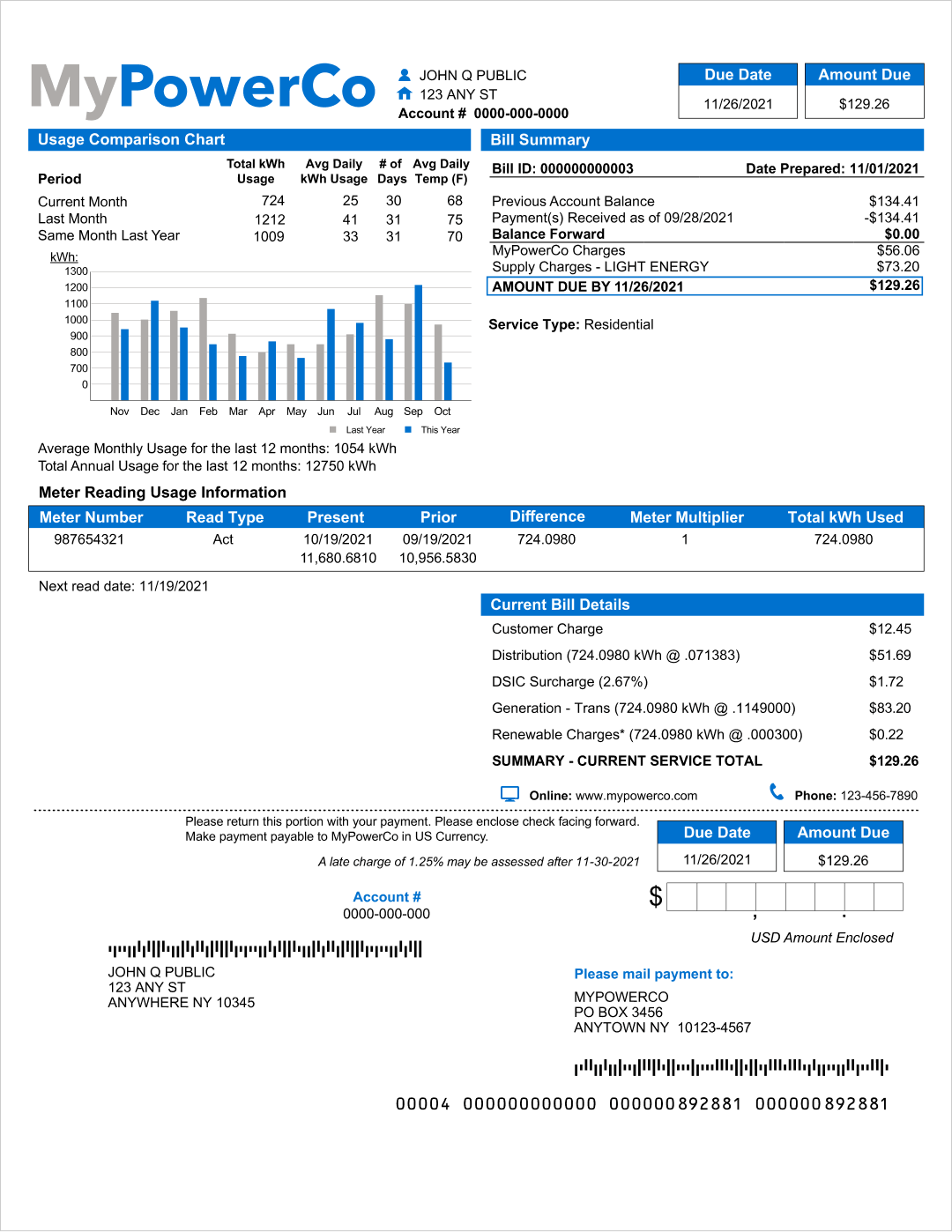
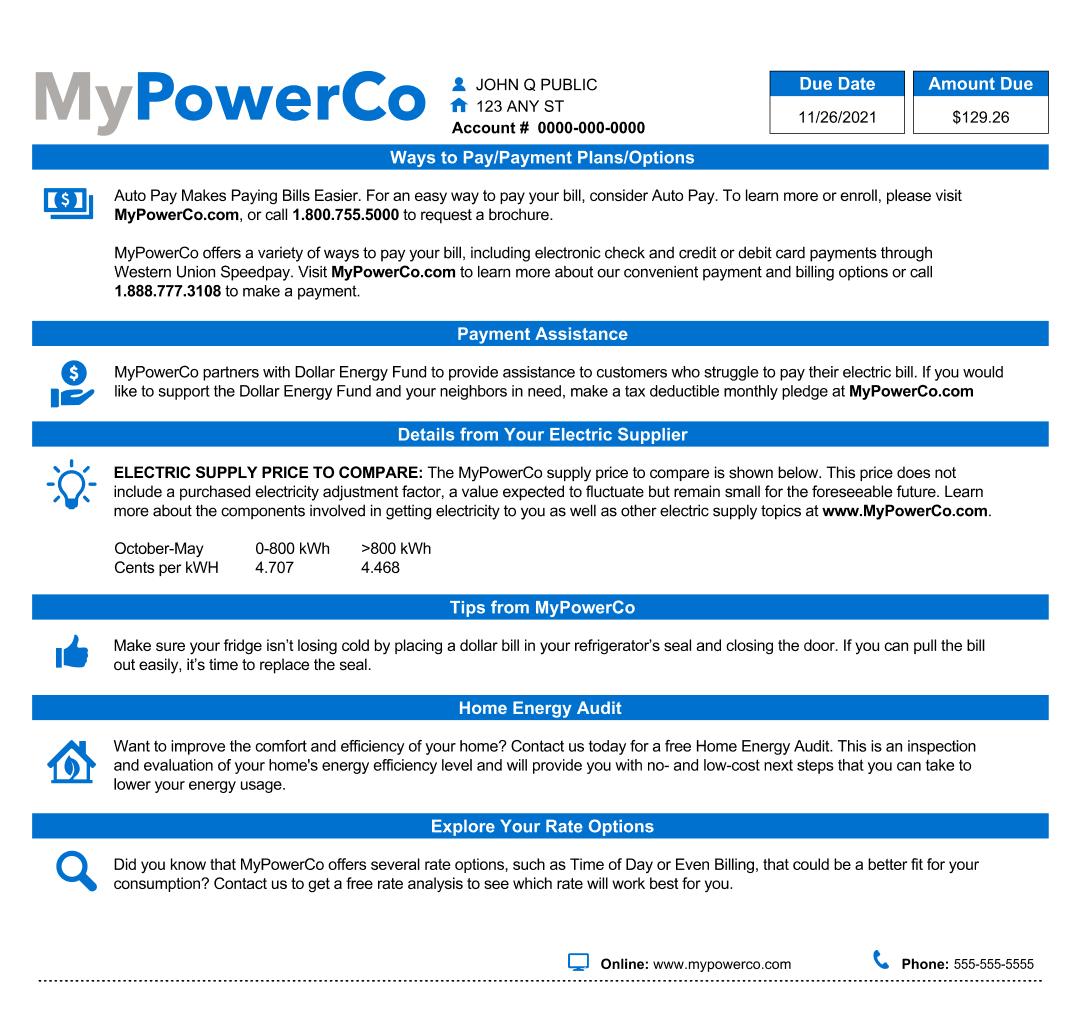
-
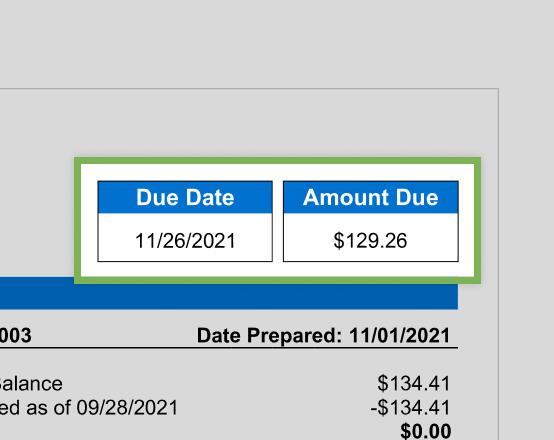 1. Total Amount Due/Balance DueThe total dollar amount based your usage, fees and services. This line item is usually accompanied with a due date when the payment must be processed.
1. Total Amount Due/Balance DueThe total dollar amount based your usage, fees and services. This line item is usually accompanied with a due date when the payment must be processed. -
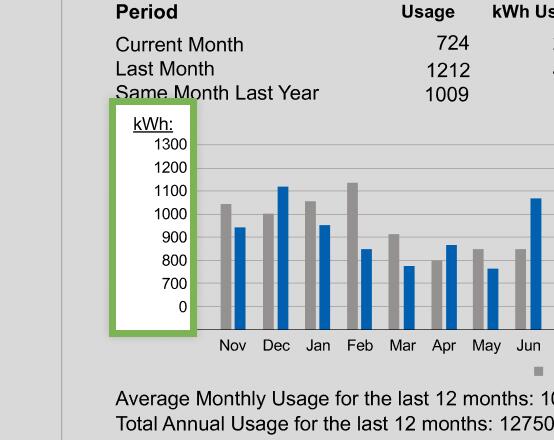 2. Kilowatt-hours (kWh)A watt is a measure for electric power and a kilowatt (kW) is one thousand of those. A kilowatt-hour (kWh) is equal to 1,000 watts of power for a one-hour time period.
2. Kilowatt-hours (kWh)A watt is a measure for electric power and a kilowatt (kW) is one thousand of those. A kilowatt-hour (kWh) is equal to 1,000 watts of power for a one-hour time period. -
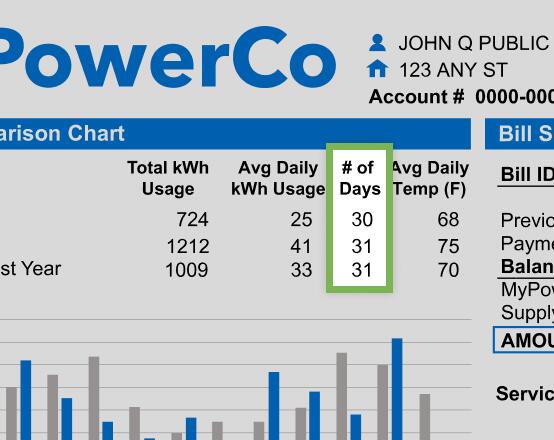 3. Days ServedBilling period for which your electric meter was read. Usually 30 or 31 days, but this can vary.
3. Days ServedBilling period for which your electric meter was read. Usually 30 or 31 days, but this can vary. -
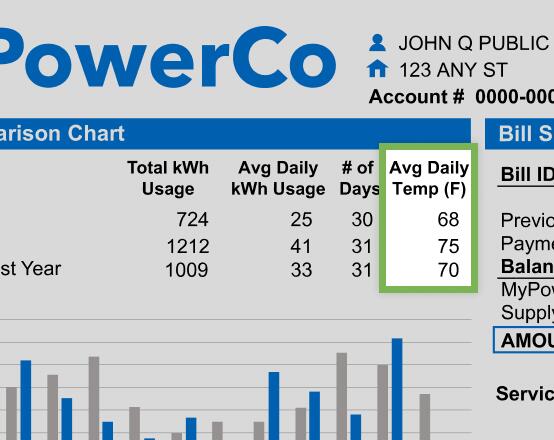 4. Average Monthly/Yearly TemperatureWeather has a big impact on your energy usage, as half of your bill could go toward heating/cooling. The greater the difference between your thermostat setting and the outside temperature, the more energy you’re using. During extreme temperatures, your bill will likely be higher.
4. Average Monthly/Yearly TemperatureWeather has a big impact on your energy usage, as half of your bill could go toward heating/cooling. The greater the difference between your thermostat setting and the outside temperature, the more energy you’re using. During extreme temperatures, your bill will likely be higher. -
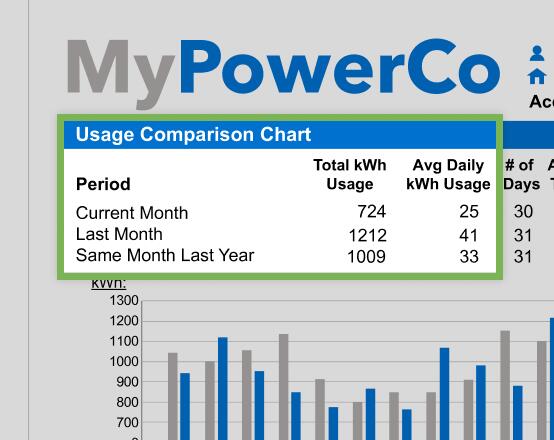 5. Usage/ConsumptionThe difference between your previous and current meter readings is the electricity usage for the current billing period.
5. Usage/ConsumptionThe difference between your previous and current meter readings is the electricity usage for the current billing period. -
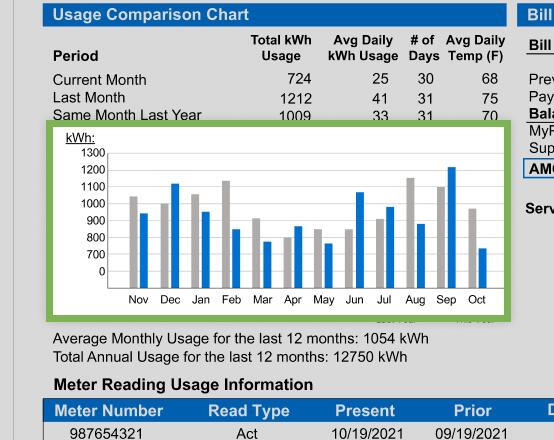 6. Electric Usage History (Chart/Graph)A chart that depicts your past energy use, detailing important information like average daily usage, cost per day for the current bill or total usage by month. This is a great tool for learning more about your usage patterns.
6. Electric Usage History (Chart/Graph)A chart that depicts your past energy use, detailing important information like average daily usage, cost per day for the current bill or total usage by month. This is a great tool for learning more about your usage patterns. -
 7. Meter #Your meter number is unique to your electric meter and is usually stamped or printed at the bottom of the face plate of the meter on your home.
7. Meter #Your meter number is unique to your electric meter and is usually stamped or printed at the bottom of the face plate of the meter on your home. -
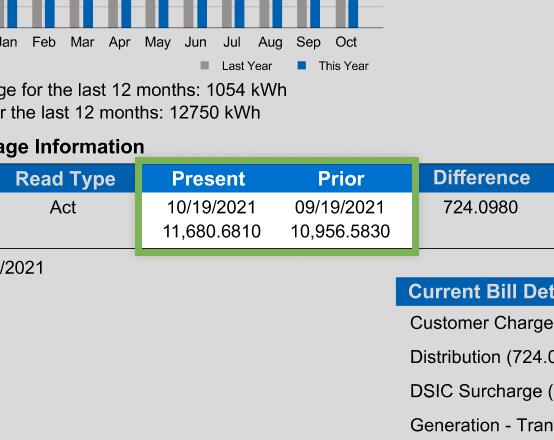 8. Meter ReadingsMost bills include both the previous month’s meter reading and the current month’s meter reading. The difference between the two is the kWh utilized in the current period.
8. Meter ReadingsMost bills include both the previous month’s meter reading and the current month’s meter reading. The difference between the two is the kWh utilized in the current period. -
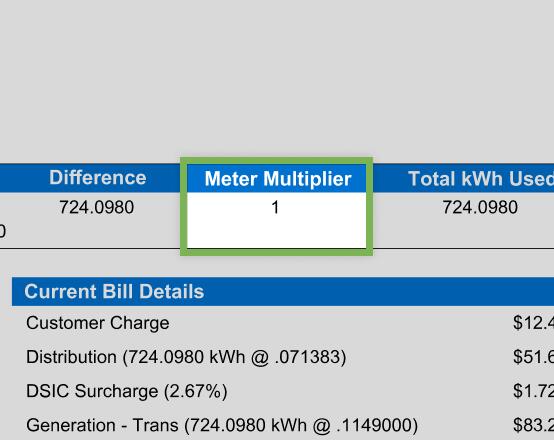 9. Multiplier/ConstantThis is applied to certain types of customers to determine usage. For most homes, the multiplier is 1. If you don’t see this on your bill, it’s not something to be concerned with as it has greater relevance to business customers.
9. Multiplier/ConstantThis is applied to certain types of customers to determine usage. For most homes, the multiplier is 1. If you don’t see this on your bill, it’s not something to be concerned with as it has greater relevance to business customers. -
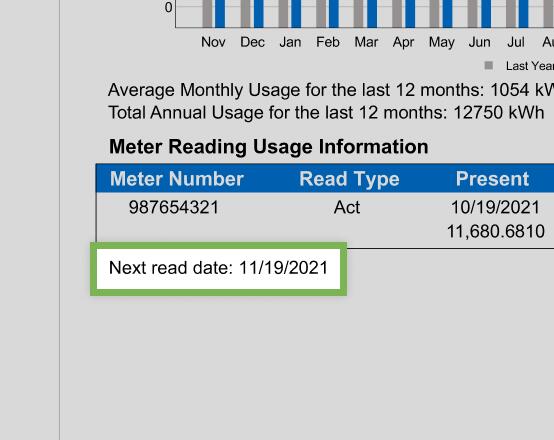 10. Next Scheduled Read DateThis is the scheduled date for your electricity meter to be read and charted for your next bill. Smart meters have allowed power companies to remotely read meters, saving time and resources usually needed to read meters in person.
10. Next Scheduled Read DateThis is the scheduled date for your electricity meter to be read and charted for your next bill. Smart meters have allowed power companies to remotely read meters, saving time and resources usually needed to read meters in person. -
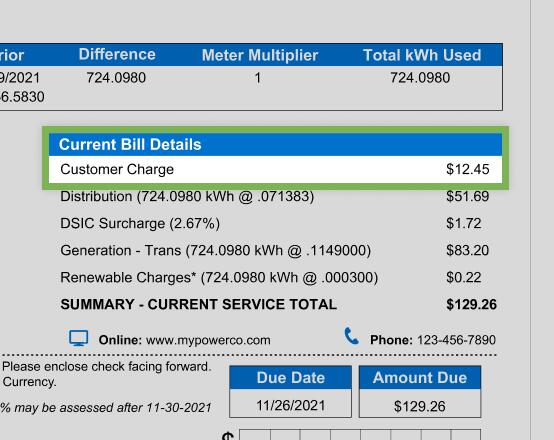 11. Other FeesMeter Charge, Customer Charge/Energy Charge. These are usually fixed costs to help recover your power company’s costs of serving you, including meter reading, billing and administration. Like the T&D charges, these will vary depending on region.
11. Other FeesMeter Charge, Customer Charge/Energy Charge. These are usually fixed costs to help recover your power company’s costs of serving you, including meter reading, billing and administration. Like the T&D charges, these will vary depending on region. -
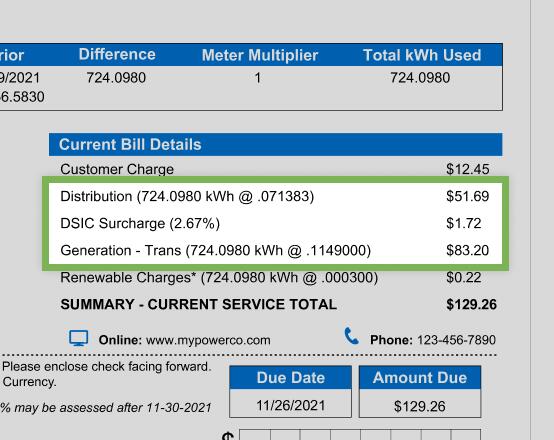 12. T&DDistribution Delivery Charge, Transmission Service Charge/Cost Recovery. These charges and fees have to do with the cost to deliver electricity from power-generating facilities to electric substations and then ultimately to your home. These will vary significantly depending on your region but will often include “distribution” or “transmission” in the name.
12. T&DDistribution Delivery Charge, Transmission Service Charge/Cost Recovery. These charges and fees have to do with the cost to deliver electricity from power-generating facilities to electric substations and then ultimately to your home. These will vary significantly depending on your region but will often include “distribution” or “transmission” in the name. -
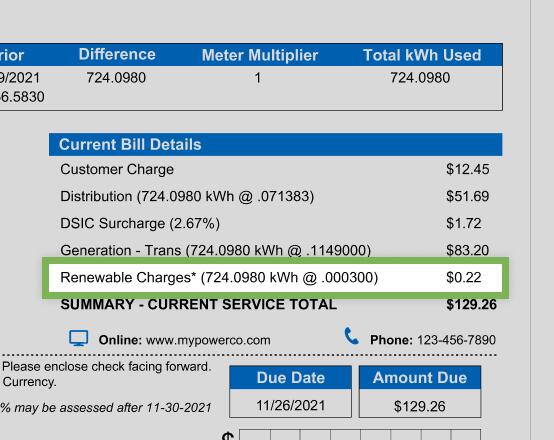 13. Renewable Energy AdjustmentYour area may have legislation that requires a certain percentage of renewable energy, such as solar and wind. This line item helps fund those measures.
13. Renewable Energy AdjustmentYour area may have legislation that requires a certain percentage of renewable energy, such as solar and wind. This line item helps fund those measures. -
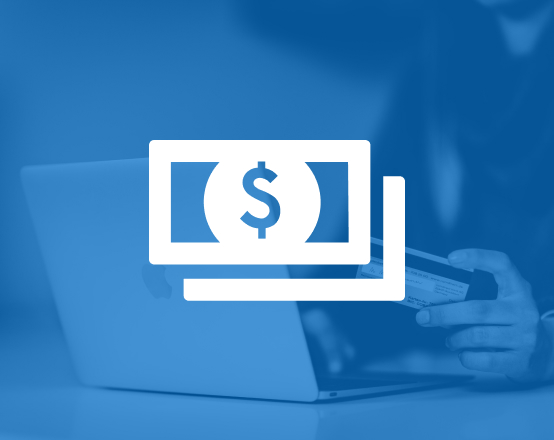 14. Ways to Pay/Payment Plans/OptionsYour power company may provide various ways to pay your bill, such as through an app, the mail or at an in-person location. Your power company may also offer payment plans if you’re having difficulty paying your bill.
14. Ways to Pay/Payment Plans/OptionsYour power company may provide various ways to pay your bill, such as through an app, the mail or at an in-person location. Your power company may also offer payment plans if you’re having difficulty paying your bill. -
 15. Financial/Government AssistanceIn some cases, power companies provide assistance when you’re having difficulty paying your electric bill. If you are already receiving benefits from a government assistance program, you may qualify for bill payment assistance.
15. Financial/Government AssistanceIn some cases, power companies provide assistance when you’re having difficulty paying your electric bill. If you are already receiving benefits from a government assistance program, you may qualify for bill payment assistance. -
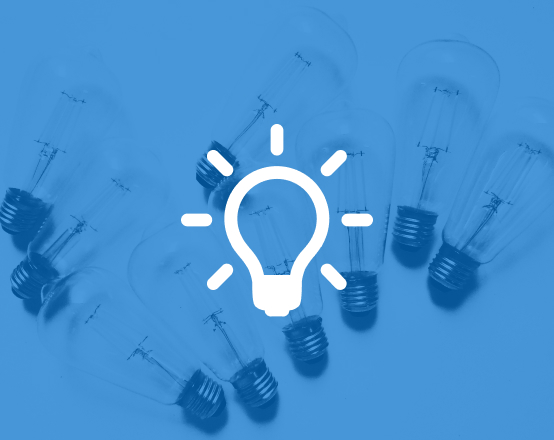 16. Electric Supply ChoicesInformation on how to choose a supplier – if that’s something available in your area. Even if you’re not interested in choosing a different supplier, you could learn more about the rate you pay and learn about additional ways to conserve energy in this section.
16. Electric Supply ChoicesInformation on how to choose a supplier – if that’s something available in your area. Even if you’re not interested in choosing a different supplier, you could learn more about the rate you pay and learn about additional ways to conserve energy in this section. -
 17. Tips for Energy EfficiencyEnergy efficiency involves making changes that maintain your home’s comfort while reducing energy use. Sometimes, power companies will include these types of tips on your bill to encourage you to take energy-efficient actions at home.
17. Tips for Energy EfficiencyEnergy efficiency involves making changes that maintain your home’s comfort while reducing energy use. Sometimes, power companies will include these types of tips on your bill to encourage you to take energy-efficient actions at home. -
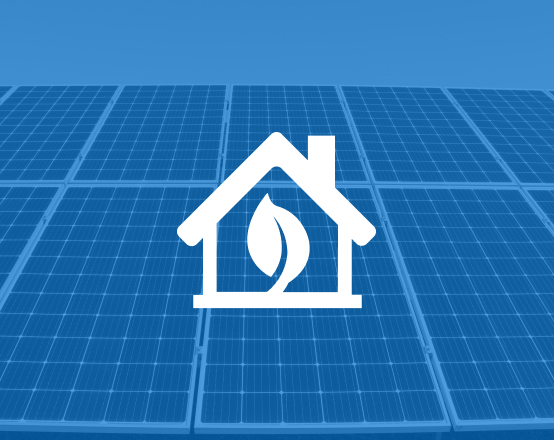 18. Home Energy AuditA free or low-cost energy assessment can help you find many ways to improve the comfort and efficiency of your home. Power companies sometimes include information on how to begin on your bill.
18. Home Energy AuditA free or low-cost energy assessment can help you find many ways to improve the comfort and efficiency of your home. Power companies sometimes include information on how to begin on your bill. -
 19. Rate(s)You may have the option to enroll in a variety of pricing plans that make it possible to save money by controlling how much electricity you use at different times of the day or week.
19. Rate(s)You may have the option to enroll in a variety of pricing plans that make it possible to save money by controlling how much electricity you use at different times of the day or week.


